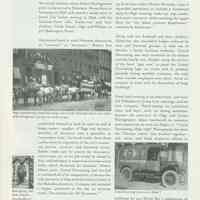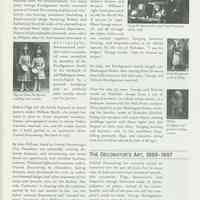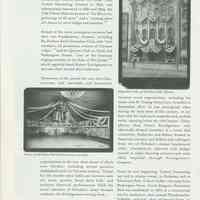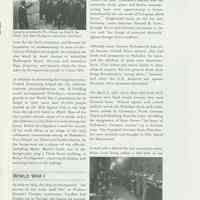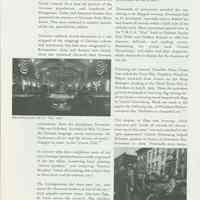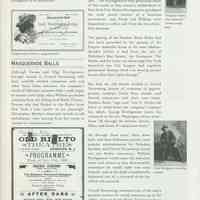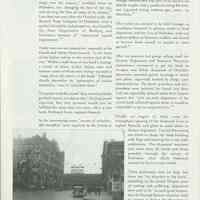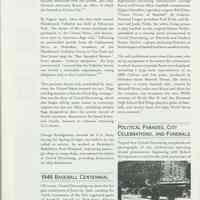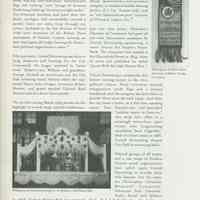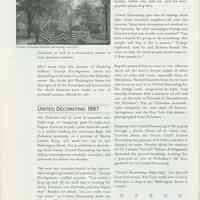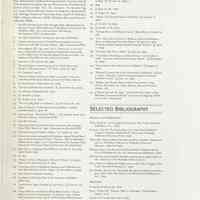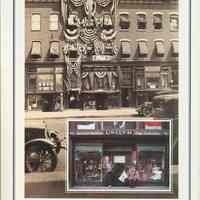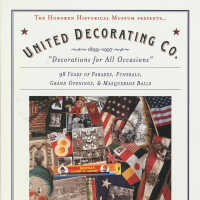Collections Item Detail
Booklet: United Decorating Co., 1899-1997. Exhibition by Hoboken Historical Museum, City Hall, Hoboken, 1997.
2002.195.0017
2002.195
Staff
Collected by Staff
Museum Collection.
1997 - 1997
Date(s) Created: 1997 Date(s): 1997
Good
Display Value: Good Notes: 2002.195.0017 Text of booklet: United Decorating Co., 1899-1997. Decorations for All Occasions. 98 Years of Parades, Funerals, Grand Openings, & Masquerade Balls. An exhibition by the Hoboken Historical Museum, Sponsored by the New Jersey Historical Commission, City Hall, Hoboken, June 27, 1997. [front cover] The Hoboken Historical Museum presents... United Decorating Company 1899-1997 "Decorations for All Occasions" 98 Years of Parades, Funerals, Grand Openings, & Masquerade Balls This exhibition made possible by a generous grant from the New Jersey Historical Commission. [inside front cover] EXHIBITION CURATORS: Robert Foster and McKevin Shaughnessy COVER LOGO AND CONCEPT: McKevin Shaughnessy BROCHURE DESIGN: Claire Lukacs RESEARCHER AND WRITER: Holly Metz ALL PHOTOGRAPHS are from the collection of the Kirchgessner family except for contemporary photos by Robert Foster (front and back covers, pages 3 and 16); Y.M.C.A. "Hut" photo from the Hoboken Y.M.C.A. collection (page 9); and the image of President Wilson's motorcade (page 10) from the Hoboken Public Library HOBOKEN HISTORICAL MUSEUM OFFICERS Robert Foster, President Marie Luizzi, Vice President Maureen Allex, Treasurer Ciorsdan Conran, Corresponding Secretary Hank Forrest, Recording Secretary HOBOKEN HISTORICAL MUSEUM BOARD OF TRUSTEES Nicholas Acocella Barbara Lippman Theresa Castellano Leonard Luizzi, Sr. John De Palma Claire Lukacs Steve Kilnisan McKevin Shaughnessy Charles Lee Vincent Wassman George Kirchgessner, City Historian Mayor Anthony Russo, Honorary Board member THE HOBOKEN HISTORICAL MUSEUM was formed in 1986. Its purpose and objectives are many. We hope to stimulate interest in the city's history, architecture, and geneaology. We offer exhibits, lectures, and walking tours, maintain a museum space in Hoboken's City Hall, and publish a magazine, Hoboken History, and a bi-monthly newsletter. The Museum also assists in the preservation of historic documents and landmarks, and acquires artifacts relating to our city's rich history. We work with organizations with similar interests, such as the Hoboken Board of Education and the Hoboken Historic Preservation Commission, to create educational programs. As one of the most active organizations in Hoboken, we are always looking for new volunteers and members to assist us. If you would like to become a Museum member and receive Hoboken History in the mail, gain reduced rates on admission to Museum events, and receive discounts on Museum gift items, write HOBOKEN HISTORICAL MUSEUM, P.O. Box 707, Hoboken, NJ 07030, or call (201)656-2240. 1997 HOBOKEN HISTORICAL MUSEUM [page 1] United Decorating Company 1899-1997 "Decorations for All Occasions" 98 YEARS OF PARADES, FUNERALS, GRAND OPENINGS, & MASQUERADE BALLS An exhibition by the HOBOKEN HISTORICAL MUSEUM Sponsored by the New Jersey Historical Commission June 27, 1997 City Hall, Hoboken Special thanks to George and Dolores Kirchgessner for sharing their stories, memories, and artifacts with the Museum. [page 2, full page photo] [caption: 35th anniversary of United Decorating Co., 1934 showing three generations of the Kirchgessner family: William (second generation), Robert (first), Catherine (second), George (third).] [page 3] INTRODUCTION "United Decorating Company, Hoboken, New Jersey, 1899-1997" surveys 98 years of local, state, and national history through the window of the oldest business in continuous operation on Washington Street. For when Robert Kirchgessner opened United Decorating Co., on Hoboken's main street in 1899, the German-born decorator and maker of costumes and banners inaugurated a tradition of helping Hoboken and surrounding communities commemorate many of their brightest, and most solemn, public events: uproarious political rallies and gala masquerade balls, the funerals of dignitaries, baseball games, ship dedications, grand Depression-era re-openings of local banks, and celebrations of Elks, Moose, and marksmen. United Decorating Go. continues today, at the same 421 Washington Street location, under the stewardship of Robert's grandson, 78-year-old George Kirchgessner. Until recently, George regularly hung flags, banners, and bunting for graduations, mayoral inaugurations, and special civic celebrations, including the 150th anniversary of the first organized baseball game,observed this past Spring. With his wife, Dolores, he runs the storefront shop,which continues to sell costumes, while also introducing items unavailable (and even unthinkable) inhis grandfather's time: "green mouth" trick chewing gum, funky plastic novelties, and postcards of Frank Sinatra. But very little-materially-has been lost of United Decorating's past: the tiny storefront is packed with hundreds of artifacts, dating back to the store's founding. Dozens of theseobjects, on loan from the Kirchgessner family, form the core of this exhibition, the HobokenHistorical Museum's tenth. Combined with text, and Museum objects and photographs, United Decorating's artifacts allow us to consider, from the vantage point of 421 Washington Street, nearly a century of events of municipal, state, and national significance. [photo lower left: United Decorating was often hired to decorate Hoboken store fronts [Herold's Bake Shop] for business anniversaries, circa 1938.] [photo middle right: United Decorating Co.advertising handbill, circa 1918.] [photo lower right: Badge for German social group, assembled at United Decorating.] [page 4] UNITED DECORATING AND THE KIRCHGESSNER FAMILY "DECORATIONS FOR ALL OCCASIONS" Not much is known about Robert Kirchgessner prior to his arrival in Hoboken. He was born in Germany in 1858 and owned a candy store in Jersey City before moving in 1899, with his German-born wife, Katherine, and four children, Frank, Emma, Olga, and William, to 421 Washington Street. Alternately listed in early Hoboken directories as "costumer" or "decorator," Robert had established himself as both by 1910—as well as badge-maker; supplier of flags and banners; installer of canopies; and a specialist in "committee suits," the hand-made, fancy dress outfits worn by organizers of the city's numerous parties, concerts, and theatrical events. Robert made sure he joined the decorators' union early on, so no job would be closed to him, and belonged to numerous German social clubs, which furthered his business.' Within fifteen years, United Decorating had out-bid or outlasted all of its competitors; it became the only purveyor of flags and decorations listed in the Hoboken directory. Company ads included a slogan, presented to this day on business cards: "Decorations for All Occasions. In its earliest years, United Decorating Co. rented the first floor Washington Street walk-up from wine-seller Charlie Weinacht. Later it expanded operations to include a downstairs shop for flags, bunting, make-up, wigs, masks, and men's costumes, while retaining the upper floor for "the ladies costume department," overseen by Katherine.3 Along with her husband and four children, Katherine also assembled badges ordered by civic and fraternal groups, in what was to become a family business tradition. United Decorating was—and continues to be—almost entirely family-run. Besides using the services of the local "sign man" to paint the United Decorating logo on trucks and to produce placards listing available costumes, the only other outside employees were those hired on occasion to assist with the decoration of large buildings.1 Frank had training as an electrician, and soon left Hoboken for Jersey City, marriage, and his own company. Hand-sewing on committee suits, and later, wo rk on sewing machines, became the province of Olga and Emma Kirchgessner, whose handiwork on costumes and rosettes can be seen on display in "United Decorating, 1899—1997" Photographs also show the "German colors" they stitched together— red, white, and black draperies affixed to buildings for pre-World War I celebrations of the local Schuetzen Corps, a German club devoted to marksmanship. [photo middle left: Wagon embellished by United Decorating, in front of 421 Washington Street, circa Robert Kirchgessner, wearing a tie, stands on steps.] [photo bottom left: Bank opening, 14th Street, Hoboken. Now the offices of the Hoboken Reporter.] [photo bottom right: United Decorating's first truck, a Model T.] [page 5] The vast majority of photographs on exhibition are from the collection of the Kirchgessner family, whose interest in photography spanned three generations, and who had an obvious business need for documentation. For many years, George Kirchgessner recalls, mounted prints of United Decorating displays and committee suit-wearing customers (including a hand-colored image featuring Robert and Katherine) lined the walls of the stairwell up to the second floor ladies' costume department. Dozens of photographic postcards, many taken by William when he first became interested in photography, demonstrated available rental costumes; all were modelled by members of the Kirchgessner family in the backyard of 421 Washington Street, camouflaged by a painted backdrop and an artificial palm usually rented out for parties. Before Olga left the family business to marry pattern-maker William Smith, she joined her sister to pose in drum majorette costumes. Emma, photographed earlier in Annie Oakley costume, married, too, and the couple moved for a brief period to an apartment above United Decorating. She died in 1931. By then William, listed as United Decorating's Vice President, was essentially running the family business, and introducing new items based on opportunity and excellent business acumen. Theatrical lights and costumes, sold to United Decorating by Hoboken's failing theaters, were introduced for rent, as orders for fraternal badges and other mainstays of the teens and twenties were on the decline. His wife, Catherine, in keeping with the tradition started by her late mother-in-law, ran the ladies' costume department and "minded the store'' downstairs when William was called out to decorate local halls and storefronts. Robert Kirchgessner died in 1936. That same year, his grandson, George, got his driver's license and became William's right-hand man until he left for World War II service in 1942. When George returned, and all through the 1950s, father and son worked together, hanging banners, bunting, and draperies — often in an official capacity for the city of Hoboken. "I was his helper," George recalls, "then he became my helper." In 1955 the Kirchgessner family bought 421 Washington Street, after renting there for more than half a century; that same year, George and Dolores Kirchgessner married. Over the next 42 years, George and Dolores would see Hoboken change from a city of shipyard workers, to a bleak urban center, to a bedroom community for Wall Street workers. They stayed on at 421 Washington Street, meeting the familiar needs of Hoboken families: hiring out canopies and carpet chairs, making weddings special with flame lights and dais draped in white and silver, hanging bunting and banners, and, in the storefront shop, selling postcards, flags, and costumes, along with the novelties adored by kids of all ages. The Decorator's Art, 1899-1997 United Decorating has certainly varied its inventory over the past 98 years, but in many ways, its basic products have remained remarkably consistent. Flags, decorations, and draperies — though fashioned today of nylon, polyester, or plastic, instead of the cotton, muslin, and silk of the past—are still the company's stock-in-trade. George Kirchgessner continues to order from the same company his grandfather used: Annin & Co., the world's oldest and largest flag manufacturer, head- [photo left: Olga and Emma Kirchgessner, modeling rental costumes.] [photo top right: George Kirchgessner with 1935 United Decorating vehicle, 1936.] [photo middle right: Emma Kirchgessner as Annie Oakley.] [photo middle right: William Kirchgessner self-portrait, in Indian costume.] [page 6] quartered in New Jersey for most of its 150 years. And yet, each generation of Kirchgessners has introduced innovations to the business, too, sometimes in response to political shifts. Increased or altered use of the American flag, for example, has long been fueled by war and "nationalist anxiety about increasing immigration"—an ironic twist considering the immigrant status of United Decorating's founder, Robert Kirchgessner made lavish use of U.S. flag-imprinted fans, pull-downs, butterflies, centers, and draperies (named after their decorative shape or use), until a code of flag etiquette, compelled by legislation in the early 1920s, condemned such practices. The national flag, the code asserted, should be considered "as a living thing;" consequently, it must never be used as drapery "in any form whatever." Red, white, and blue bunting was the recommended substitute, and was quickly incorporated into company displays. In the early years, even the longest extension ladder was not enough for very tall buildings. Robert Kirchgessner "had to go up the stairs and stretch out the windows," George Kirchgessner explains. "You'd go up on the roof and hang the decorations down. Then you'd come down, tie it on the next floor, and work your way down." Most often, change occurred at United Decorating in response to technological developments. The elimination of trolley wires brought an end to United Decorating's "street work," and allowed the company to focus on the decoration of storefronts. Until the Great Depression, Olga and Emma Kirchgessner worked as hand-sewers on mourning draperies, rosettes, and committee suits; today with the increased availability of inexpensive, machine-made products, nearly all United Decorating stock is catalog-purchased and most are made of synthetic fabrics and plastics. Hand-work has not entirely disappeared from the decorating business, however. George Kirchgessner developed an expertise in banner design, in which letters made of show card are carefully fixed with ticket hooks to a cloth background. George's photographs of his own displays over the past fifty years show banners of increasing complexity and skill, designed for weddings, talent shows, political fund-raisers, and community meetings. 1909 Hudson-Fulton Celebration One of Robert Kirchgessner's first business cards proudly announced an impressive accomplishment: "Decorator for Hudson-Fulton Celebration and Mardi Gras." The Hudson-Fulton Celebration, held from September 25 to October 9, 1909, commemorated 300 years of Hudson River-based commerce and transportation, and was said to be "the greatest and most brilliant of its kind ever held in America." Hudson communities from New York Harbor to Canada participated. Organizers described the celebration as a commemoration of the importance of Hudson River commerce, the 1609 discovery of the river by Henry Hudson in the Half Moon, and Robert Fulton's contributions to steam [photo top left: Imported ticket hooks affix show card letters to drapery.] [photo middle left: Showcard lettering and banners for Grogan election campaign"; text below is as found on banner in image: END HOBOKEN'S DISGRACE BY VOTIING FOR MAYOR John J. Grogan FOR COUNCILMEN AT LARGE E.J. BORRONE S.E.MONGIELLO L.. DE PASCALE * WARD COUNCILMAN * 1ST WARD L. HAACK 2ND WARD E. MURNANE 3RD WARD A. DAMATO 4TH WARD T. GIORDANO 5TH WARD T. O. REILLY 6TH WARD J. BARTLETTA VOTE ROW "B" and BE FREE] [photo bottom: Business card, circa 1909.] [page 7] transportation. But they also promised spectacular and novel events, including an aeronautical display by Wilbur Wright around the Statue of Liberty, and fleets of military and "peace" ships illuminated by "hundreds of searchlights and tons of red fire." Water parades with sailing reproductions of the 1609 Half Moon and Fulton's 1807 Clermont, as well as numerous street processions, ensured festivities on both land and water. Although the Hudson-Fulton Celebration centered around New York State locations, Hoboken was not to be outdone, nor would city fathers allow Hudson's Hoboken landing, Fulton's Hoboken-based steam navigation experiments, and the steam inventions of Hoboken patriarch John Stevens, to go unrecognized. It sponsored its own "Hudson-Fulton Mardi Gras" to coincide with the New York festivities, and established itself as "the only city to celebrate locally on the Jersey shore." United Decorating was called upon to decorate Hoboken's City Hall for the October 6th and 7th Mardi Gras, "one of the biggest celebrations in Hoboken's history." For a week prior to the celebration, Robert Kirchgessner's display of flags and bunting drew high praise, along with accolades for an independent electrician's show of lights. "At night the blaze of thousands of incandescent lights on the City Hall, and other public and private buildings, make Hoboken a veritable white city," noted one reporter. Electricity was available in Hoboken from 1886, when the city's chief engineer turned the switch at the Monroe Street electric plant, allowing exterior lamps to be illuminated. But for many Hobokenites, electricity continued to be a novelty for years thereafter. According to George Kirchgessner, some families did not install interior electric lights until the late 1920s. On October 7, 1909, an estimated 200,000 onlookers lined the two-mile parade route and cheered 8,000 marchers (many in high hats and frock coats), dozens of decorated carriages, motor cars, and floats representing "practically every Industry of Hoboken." A model of John Stevens' steamer Phoenix, "which Hobokenites declare floated in the waters of the Hudson River before Fulton's Clermont was designed," was greeted by clanging bells and armloads of confetti. At the end of the parade, a Mardi Gras King and Queen, selected by popular vote through the local paper, were escorted by a Hoboken riding club to the grand, fancy dress ball at the Odd Fellows Hall, where the festivities continued until four o'clock the following morning. Celebrations in "Little Bremen" and Schuetzen Park From the l880s to 1918, the influx of German immigrants to Hoboken was so great the mile-square city became known as "Little Bremen." With its German beer gardens, piers lined with German ocean liners, German-language theaters, and numerous athletic clubs devoted to boating, rowing, and marksmanship, Hoboken was a fine location for a [photo left: Photo postcard of Hoboken City Hall during Hudson-Fulton "Mardi Gras," 1909.] [photo bottom left: Social club committee wearing identical costumes, circa 1905. Emma Kirchgessner seated first row, right.] [page 8] German-born decorator of civic celebrations. Many of the city's celebratory events were held in the fraternal Independent Order of Odd Fellows Hall, 4,14 Washington Street — fortuitously located across the street from United Decorating. Erected in l853 and subsequently renovated in 1881 and 1893, the Odd Fellows Hall was known as "the Mecca for gatherings of all sorts," and a "meeting place of a dozen or more lodges and societies." Several of the more prestigious societies had their own headquarters, however, including the Hudson Street Deutscher Club, with "200 members, all prominent citizens of German origin, and the Quartet [sic - Quartett] Club on Tenth and Washington Streets, "one of the foremost singing societies in the State of New Jersey," which regularly hired Robert Kirchgessner to decorate their second-floor ballroom. Directories of the period list over 100 clubs, societies, and charitable and benevolent organizations in the city, three dozen of which were German, including several societies established solely for German women. Except for the months when ballroom interiors were too warm, parties, fancy dress balls, and exclusive theatrical performances filled the social calendars of Hoboken's many German residents — the Kirchgessners among them. From family photographs, we know Robert Kirchgessner alone belonged to at least three German social organizations, including the music club M. Gesang Verein Lyra, founded in September 1870. In one photograph taken during the early years of this century, we see him with his trademark mustache and puckish smile, standing below the club banner. Other photos show Emma Kirchgessner with identically-dressed members of a social club committee; Katherine and Robert dressed in theatrical costume; and Robert with colleagues from one of Hoboken's schuetzen (marksmen) clubs, triumphantly adorned with badges earned at target shooting contests—and most likely acquired through Kirchgessner's company. From its very beginning, United Decorating was tied to schuetzen events, in Hoboken and in Schuetzen Park. A short trolley ride away from Washington Street, North Bergens's Schuetzen Park was established in 1875 as a recreational site for marksmen, their annual Plattdeutscher Volksfest, and later, their retirement home, in what was then known as Union Hill. Each August, United Decorating provided decorations [photo left: Interior of Odd Fellows Hall with decorations, circa 1900.] [photo right: Independent Order of Odd Fellows Hall, Hoboken.] [page 9] for the Park's festivities; and because the popularity of marksmanship in turn-of-the-century Hoboken was so great, the company was also hired by local schuetien to embellish Washington Street. German and American flags, draperies, and banners lined the route taken by the equestrian parade to Union Hill. In addition to decorating for temporal events, United Decorating helped the city celebrate concrete accomplishments, too. A building trend accompanied Hoboken's tremendous growth in pre-World War I population (at its height in 1910, more than 70,000 people resided in the Mile Square City—a vast leap from the 43,000 listed in 1890). Most of the city's public schools, many of its banks, and a 1911 addition to City Hall were built during this boom. Robert Kirchgessner's need for records of his work allows us an image of the 1913 celebratory cornerstone-setting of Hoboken's No.1 School, on Third and Garden Streets. In the foreground are a cluster of city officials, including Mayor Martin Cook; but in the background, atop a Third Street building, is Robert Kirchgessner, admiring his display, and watching history in the making. WORLD WAR I As early as 1914 the Jersey Journal reported, "the sorrow of war made itself felt" in Hudson County's German community. Conflict had broken out in Europe, the August 24 account continued, and officials of the fortieth annual Schuetzen Park Plattdeutscher Volksfest "were busy gathering funds to help their brethren in the Fatherland" obtain German Red Cross battlefield aid." ' Within the year, Hoboken's marine and rail terminals, docks, piers, and diverse manufacturing base were experiencing a boom, stimulated by the war needs of European allied forces.~° Heightened focus on the war with Germany, notes historian Howard B. Furer, brought fierce anti-German sentiment to the city, and "the charge of potential disloyalty" against foreign-born residents. Although many German Hobokenites had not yet become United States citizens, they had lived—and prospered—in Hoboken for years, and the children of many were American-born. Civic virtue and sworn loyalty to their adopted country did not prevent them from being denounced as "enemy aliens," however, and when the U.S. declared war against Germany, their ostracism intensified. On April 6, 1917, more than local dock workers were fired simply because they were German-born. Federal agents and armed soldiers seized the Hoboken docks and ocean liners owned by Germany's North German Lloyd and Hamburg-Amerika Lines, heralding the designation of River Street — "the heart of Hoboken's German section" — as a military zone. Two hundred German-born Hobokenites were arrested and brought to Ellis Island for deportation. Armed with a federal law that prevented enemy aliens from living within a half-mile of any [photo top left: Laying the cornerstone for No. 1 School, now David E. Rue School, 1913 - Robert Kirchgessner watches from Third Street.] [photo bottom right: Cafeteria, Hoboken Y.M.C.A. "Hut," during World War I.] [page 10] military zone, government officials evicted hundreds of German families and closed their shops. The government would later concede the law was unworkable for Hoboken — its mile-square dimensions would have necessitated the forced removal of at least 90 percent of the German population, and hundreds of Hungarians, Turks, and Austrians besides — but permitted the eviction of Germans from River Street. They were confined to another section of the city, patrolled by soldiers. Germans suddenly found themselves in a city stripped of the trappings of German culture and community that had once invigorated it. Restaurants, clubs, and theaters were closed; those that remained obscured their German orientation. Even the prestigious Deutscher Club von Hoboken, founded in 1864 "to foster the German language, social intercourse, the furtherance of art, and the science of music," changed its name, to the "Union Club." In concert with their neighbors, most of the city's German families became totally engrossed in the war effort, conserving food, planting "victory gardens," and enduring "heatless Mondays" (when all buildings did without heat to allow more coal for military use.) The Kirchgessners did their part, too, and more—for they were vendors of one of the city's most popular wartime items: American flags. In cities across the country, flag retailers reported "an unprecedented demand and runaway market" created by the war." And in Hoboken, reminders of the war were inescapable: The city was the point of embarkation and debarkation for three million doughboys during the years of United States involvement in World War I. Thousands of servicemen crowded the city, waiting to be shipped overseas. Diversions had to be developed, especially since a federal law had closed all taverns within a half-mile of the military zone. Many servicemen passed time in the Y.M.C.A. "Hut," built in Hudson Square Park (Fifth and Hudson Streets) to offer hot showers, billiards, and reading rooms. Welcoming the troops were United Decorating's red-white-and-blue draperies, which remained on display for the duration of the war. Following the historic Versailles Peace Treaty that ended the Great War, President Woodrow Wilson returned from France on the George Washington, docking at the Third Street Pier in Hoboken on July 8, 1919. There the president greeted thousands of cheering, flag-waving residents from a reviewing stand draped with flags by United Decorating. Much was made in the papers the following day, of President Wilson's comment that "Hoboken is a beautiful city." The display of flags and bunting, which reporters said "broke all records for decorations up to that time," was only matched by the "gala appearance" United Decorating helped Hoboken present in honor of Armistice Day, November 11, 1919. "Practically every home, [photo left: Billiard Room of the Y.M. C.A. "Hut, "1918.] [photo lower right: President Wilson's motorcade from Hoboken piers, July 8, 1919.] [page 11] public building, and business place in the city, the Jersey Journal reported, "displayed the national colors," as Hoboken celebrated the returning servicemen and the end of military occupation of its waterfront. Masquerade Balls Although Emma and Olga Kirchgessner brought success to United Decorating with their carefully stitched committee suits and other fancy dress costumes, the company's rental of elaborate costumes didn't really begin in earnest until 1929, when William purchased costumes from the failing local Rialto Theater. Patrons who had flocked to the Rialto from New York a year earlier to see playwright Christopher Morley's theatrical revivals of old melodramas, were turning from live events to cinema for entertainment. In a sense, Morley's productions of After Dark and The Black Crook forestalled the inevitable; as early as 1915. "moving picture exhibitions" in Hoboken outnumbered theater halls three to one. The Kirchgessners were personally aware of this trend, as they owned a nickelodeon in New York City. Robert Kirchgessner purchased the early movie theater as a business investment, and Frank and William were dispatched to collect cash from the tiny silent-film showcase. The passing of the Hudson Street Rialto had also been preceded by the passing of the Empire vaudeville house at the same address; decades earlier it had been the site of Hoboken's first theater, the Germania. The Rialto, and the Lyric — on whose stage New York theatrical star Lily Langtry had regularly performed — became third-run moving picture houses after their 1929 closings. But first the old theater yielded to United Decorating dozens of costumes of gypsies, pirates, cowboys, Uncle Sam, monks, and French aristocrats with their own tiaras. Hudson Street "sign man" Leo T. Devlin was hired to hand-letter the company's costume list, which, George Kirchgessner notes, has remained in the 421 Washington Street storefront "all through the thirties, forties, fifties, and sixties. It's always been there." All through those years, fancy dress balls, and then Halloween parties, were popular entertainments for Hoboken families, and United Decorating rented out the Rialto costumery. William Kirchgessner would repair the elaborate tiaras and crowns as they deteriorated; sometimes he would make new ones himself, such as the sheik's headdress he fashioned out of a trimmed der... [truncated due to length]


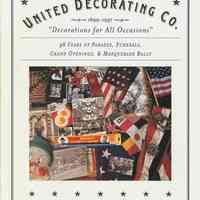
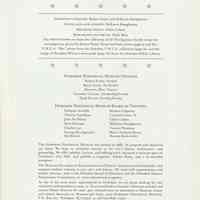
![pg [1] title page](https://d3f1jyudfg58oi.cloudfront.net/11047/image/795c8770-fa9d-11ed-a641-b3912f9925a9-uFeg5dc.tn.jpg)
![pg [2]](https://d3f1jyudfg58oi.cloudfront.net/11047/image/7a8ddb80-fa9d-11ed-a641-b3912f9925a9-uFeg6QP.tn.jpg)

